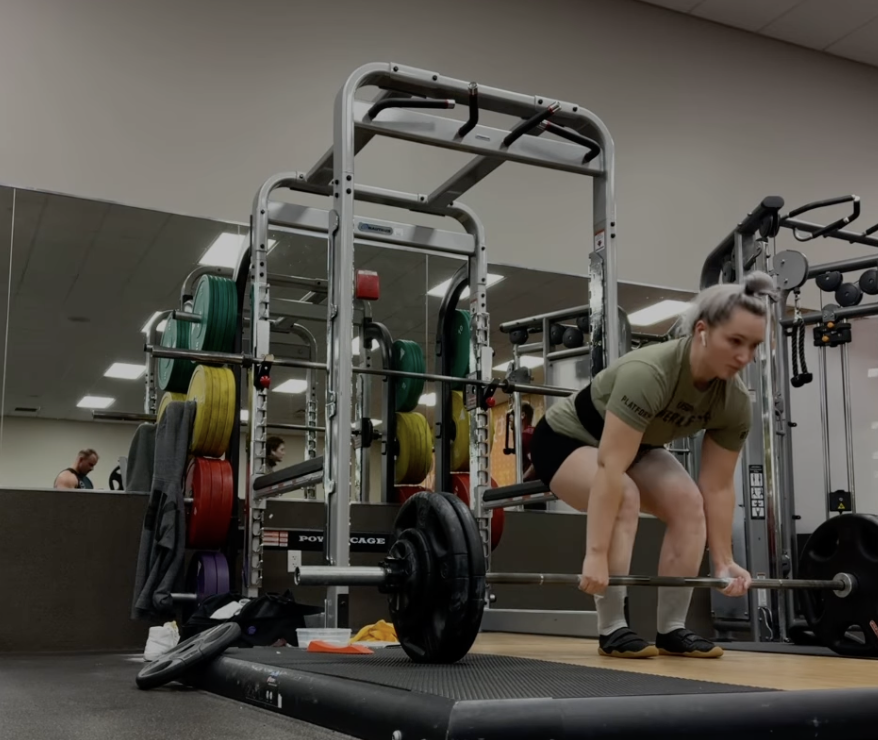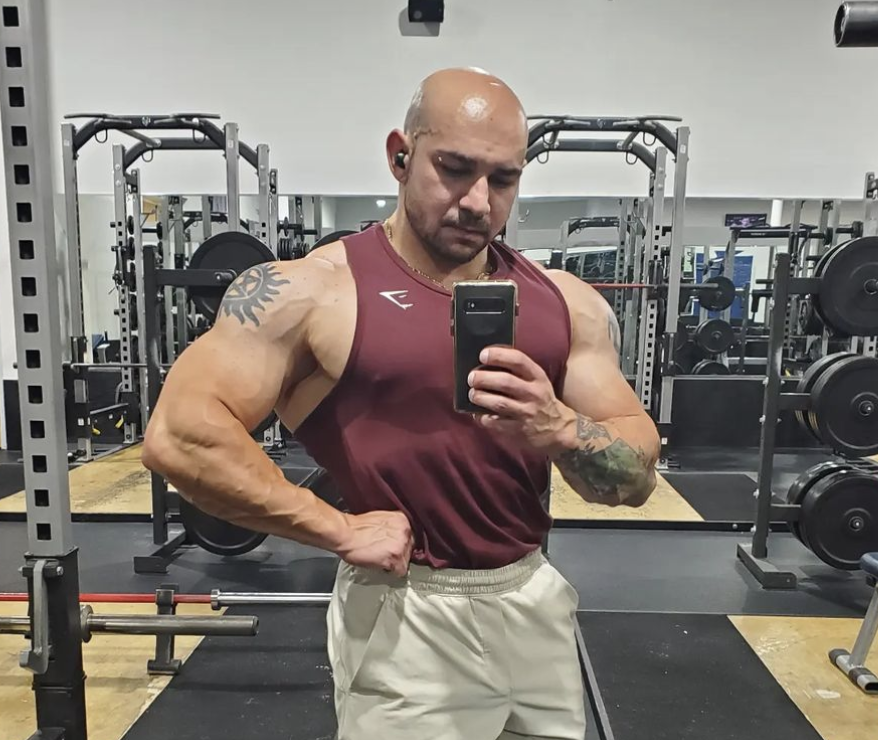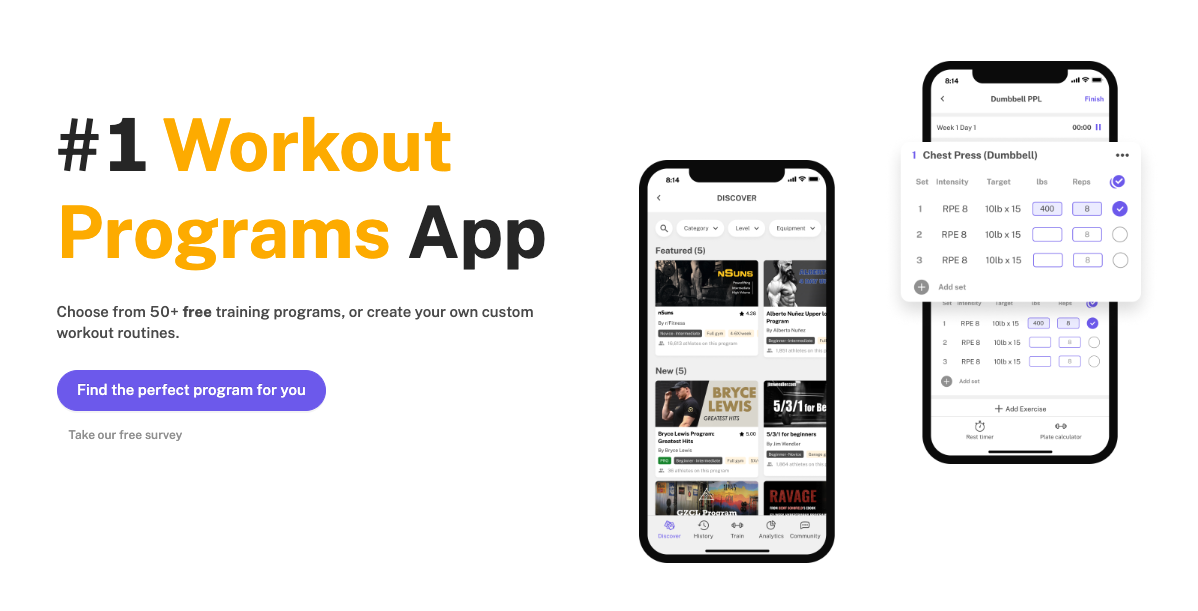The Push Pull Legs Routine for Powerbuilding
Written by the Boostcamp staff
Push Pull Legs Routine for Powerbuilding
Welcome to the world of powerbuilding! If you are someone that is looking to build strength and increase muscle mass simultaneously, then powerbuilding is the way to go. Powerbuilding is a mix of movements, volumes, and intensities that combine powerlifting and bodybuilding to give you the best of both worlds. When it comes to a good powerbuilding split, the push pull legs (PPL) routine might be just what you need. This popular training split is designed to target different muscle groups and movement patterns, allowing for effective workouts and optimal results. Whether you're a beginner, intermediate lifter, or advanced trainer, the push pull legs routine can be tailored to suit your goals and fitness level.
In this blog, we will explore the concept of push pull legs, how it can benefit powerbuilding, delve into intermediate and advanced workouts, address common concerns, and provide workout schedules and exercise recommendations.
Powerbuilding Overview

What is Powerbuilding?
Powerbuilding is a hybrid approach that combines elements of both powerlifting and bodybuilding. The goal of powerbuilding is to improve overall strength while also developing a muscular and aesthetic physique. This type of training approach is especially popular for beginner and intermediate lifters, who can experience those newbie gains (putting on size and strength pretty quickly).
Why do Powerbuilding?
Combines elements of powerlifting and bodybuilding
Develop both maximal strength and muscle size
Improve overall athletic performance and functional fitness
Maintain variety and balance in training
Cater to a broader range of goals and preferences
Powerbuilding programs are designed to increase maximal strength in the main lifts (squat, bench, and deadlift) while also incorporating higher-repetition accessory work to promote muscle hypertrophy. Workouts typically start with lower rep and heavier weight main lifts, then move on to higher rep and lower weight isolation exercises.
Key Elements of Powerbuilding Programs Include:
Emphasis on both maximal strength and muscle hypertrophy
Focus on the three main lifts (squat, bench press, and deadlift) and bodybuilding accessory exercises
Combination of low-repetition, high-weight sets for main lifts and moderate to high-repetition sets for accessory work
Beginner-level powerbuilding programs generally uses linear progression for compound lifts (week-over-week weight increases) and double progression for accessories
Intermediate/advanced-level powerbuilding programs uses periodization for compound lifts (training cycles to push maximal strength) and double progression for accessories
Understanding the Concept of Push Pull Legs Routine
Now that we have established what powerbuilding is, let's taken a look at the push pull legs routine and see why it is a beneficial workout routine for powerbuilding. The push pull legs routine is a workout program that organizes training sessions based on different movement patterns and muscle groups. Instead of targeting specific body parts each day, the push, pull, and leg workouts are split into separate training sessions. The push day focuses on exercises that involve pushing movements, such as bench press and overhead press, which primarily target the chest, shoulders, and triceps.
The push pull legs (PPL) routine is an effective way to split your workouts and optimize your training. By dividing exercises into push, pull, and leg workouts, you can ensure that all major muscle groups are targeted, as well as adequate rest and recovery in between training sessions, allowing for balanced muscle growth and strength gains.
The pull day involves pulling movements, like barbell rows and pull-ups, that primarily work the back, biceps, and rear delts. Finally, the leg day concentrates on lower body exercises, including squats and deadlifts, targeting the legs in their entirety.
The Push Pull Legs Split Explained
As stated above, on push day, the focus is on exercises that involve pushing movements, primarily working the upper body muscles, such as the chest, shoulders, and triceps.
On pull day, the emphasis is on exercises that involve pulling movements, primarily targeting the back, biceps, and rear delts.
On leg day, the focus shifts to exercises that target the lower body as a whole, including quads, the hamstrings, the glutes, and calf muscles.
By structuring your workouts around these movement patterns, you can ensure that each muscle group gets the attention it needs, leading to better overall muscle development and strength gains. The push pull legs routine allows you to train different body parts on different days, giving you the opportunity to maximize training frequency and recovery time, both of which are essential for muscle growth.
Benefits of a Push Pull Legs Split
The push pull legs split offers several benefits that make it a popular choice among fitness enthusiasts. One of the key advantages of this training split is the ability to allow proper rest time for muscle recovery. By training different muscle groups on different days, you can ensure that each muscle group gets the rest it needs before being trained again. This can lead to better muscle growth, as muscles require time to repair and rebuild.
Another benefit is the ability to target specific muscle groups with dedicated exercises. With push day, pull day, and leg day, you can focus on working different muscle groups with exercises that are specifically designed to target those muscles. This can lead to better muscle development and more balanced overall physique.
The push pull legs routine also allows for progressive overload, which is crucial for muscle growth. As you progress in your training, you can increase weights, reps, or sets, gradually challenging your muscles to adapt and grow stronger. By incorporating a good mix of compound exercises and isolation exercises, you have the flexibility to vary your training program and stimulate muscle growth in different ways.
Additionally, the push pull legs split provides a more balanced full-body workout compared to a traditional bro split. With bro splits, you often end up training certain muscle groups more frequently than others, leading to muscle imbalances. The push pull legs routine ensures that you're training all major muscle groups, creating a more well-rounded physique and reducing the risk of muscle imbalances.
Lastly, the push pull legs split offers flexibility in workout selection and training program. You can choose from a wide range of exercises for push, pull, and leg workouts, allowing you to customize your training program based on your preferences, goals, and equipment availability. This flexibility ensures that you enjoy your workouts and stay motivated, while still achieving your desired results.
Why Powerbuilders Specifically Will Benefit from the Push Pull Legs Routine

The push pull legs routine is great for powerbuilders because it can be versatile and beneficial for individuals at different fitness levels. Whether you're a beginner, intermediate lifter, or advanced powerbuilder, the push pull legs routine can be adapted to suit your needs and goals. Let's take a closer look at how each group can benefit from this training split.
Beginners and Push Pull Legs Routine
If you're new to powerbuilding, the push pull legs routine can be a great way to start building muscle mass and increasing overall strength. As a beginner, it's important to focus on proper form and exercise selection to lay a solid foundation for future progress. The push pull legs routine allows you to incorporate compound exercises, which target multiple muscle groups at once, providing a more efficient use of your training time.
For beginners, it's recommended to start with lower training frequency, such as three sessions per week (a push day, pull day, and a leg day). This allows for their to be time for muscle recovery and adaptation. Gradually increase the training intensity and frequency as you progress, and consider incorporating different training techniques, such as supersets or drop sets, to add variety and challenge to your workouts.
Intermediates and Push Pull Legs Routine
For those who have been into powerbuilding for a bit longer, the push pull legs routine can be a great way to continue making progress and building muscle mass. At this stage, you probably have a good foundation of strength and training experience, allowing you to increase training frequency and intensity.
With intermediate training, progressive overload becomes essential. This means progressively increasing the weights, reps, or sets to challenge your muscles and further stimulate muscle growth. Heavier compound movements, like squats and deadlifts, should form the foundation of your training program, while isolation exercises, like bicep curls and lateral raises, can be added to target specific muscle groups.
Balancing push, pull, and leg workouts throughout the week is also crucial for effective powerbuilding training. This ensures that each muscle group gets adequate attention, rest, and recovery time. Take advantage of advanced training techniques and different ways to structure your training sessions, such as incorporating supersets or drop sets, to keep challenging your muscles and achieving better results.
Advanced Trainers and Push Pull Legs Routine
For advanced powerbuilders, optimizing the push pull legs routine involves utilizing heavier weights and different exercises. Emphasizing proper rest time and workout split is crucial for maximizing results. Incorporating various ways to structure the routine can provide flexibility and avoid plateaus in progress. Additionally, focusing on building muscle mass with the push pull legs split can be achieved through a combination of day splits and compound lifts, offering the best options for single muscle development within the rep range. This approach moves away from the traditional bro split and offers a more comprehensive and effective strategy for weight training.
Delving into the Push Pull Legs Workouts for Powerbuilding
When it comes to push pull legs workouts for powerbuilding, your workouts should be based around adding size and strength. Again, powerbuilding is the combination of powerlifting and bodybuilding, so you want to have a variety of different movements in there.
For example, heavy compound movements such as the squat, bench, and deadlift are crucial, as they are going to be the exercises that build the base. They will build the base strength, and some dense, quality muscle mass. This is the powerlifting portion of a powerbuilding routine, and should not be left out.
Then, you also need to have the higher volume isolation exercises in there, for hypertrophy, as they help to fine tune the muscles. This is the bodybuilding portion of a powerbuilding routine, and absolutely essential for making progress.
Addressing Common Concerns with the Push Pull Legs Routine
Despite the widespread popularity of the push-pull-legs (PPL) routine, there are common misconceptions and concerns that need addressing. One prevailing concern is whether the PPL routine allows enough recovery time for each muscle group. Additionally, individuals often question whether it's suitable for beginners and how to customize it based on individual goals and fitness levels. Some also wonder if this training approach limits the frequency of training particular muscle groups. It's vital to address these concerns to provide clarity and ensure that individuals make informed decisions about incorporating the PPL routine into their workout regimen.
Are 6 day Push Pull Legs too Intense?
The 6 day push pull legs routine, spread over a week, allows for adequate recovery time between workouts. When managed properly, this split provides an effective training program with a rest day included. With proper rest and form, it can lead to great results in muscle gains and strength.
Workout Length: Is it Too Long?
The push pull legs workout program can be managed efficiently to avoid excessively long training sessions. The optimized training frequency in this routine ensures that workouts are effective without being too lengthy. With proper management and structure, the push pull legs routine allows for efficient workout length and better recovery.
Push Pull Legs Routine Workout Schedules
Exploring workout schedules for the push pull legs routine can involve several variations, such as the classic 3-day split or the popular bro split. When designing your schedule, it's vital to consider targeting single muscles with adequate rest and recovery for optimal results. Weight training enthusiasts may find adjusting the rep range and exercise selection to be the best option for their needs, emphasizing compound lifts for overall development.
The 3-Day Push Pull Legs Workout Schedule
Looking for an effective workout schedule that offers a balanced training split for full body workouts? The 3-day push pull legs workout schedule might just be the best option for you. This workout schedule allows adequate rest time and recovery between training sessions, ensuring that each muscle group gets sufficient attention and time to recover. By focusing on training different muscle groups on separate training days, it provides an optimal training frequency for muscle growth and recovery. Whether you're a beginner or an intermediate lifter, this day split is a suitable choice for anyone looking to incorporate single muscle training, weight training, and compound lifts into their routine while working within an appropriate rep range.
The 4-Day Push Pull Legs Workout Schedule
When aiming for muscle hypertrophy and progressive overload, a 4-day training split like push pull legs offers increased training frequency for muscle groups. This routine allows for additional training sessions, promoting muscle gains and providing flexibility in exercise selection, making it the best option for single muscle focus and compound lifts. With the enhanced training frequency and varied rep range, this workout schedule optimizes weight training for muscle growth, making it an effective alternative to the traditional bro split.
The 5-Day Push Pull Legs Workout Schedule
Maximizing training frequency, the 5-day split optimizes muscle growth and strength gains with focused sessions for each muscle group. Ideal for diverse training goals and experience levels, this split provides ample opportunities for weight training, incorporating compound lifts in a single muscle group focus. This approach caters to advanced trainers seeking a balanced rep range, making the 5-day split a best option for a comprehensive push pull legs routine. Embracing this bro split allows individuals to structure their workout week efficiently, promoting overall muscle development and progressive gains.
The 6-Day Push Pull Legs Workout Schedule
Looking for an extensive training schedule that offers high training frequency and volume for muscle groups? The 6-day push pull legs workout schedule might be the best option for you. With dedicated training days, this workout schedule allows targeted training for each muscle group without overlooking any specific muscle. If you're aiming for optimal muscle growth and training frequency, then this workout schedule is designed to cater to your needs. It's a great choice for individuals with specific training goals and ample time for training, enabling them to focus on single muscle groups during weight training sessions while incorporating compound lifts for maximum effectiveness. This day split routine provides ample opportunity to work within the ideal rep range for muscle hypertrophy and strength gains.
Is the Push Pull Legs Routine the Best Workout Split for Powerbuilding?

Considering the goals of powerbuilding, schedule, and personal preferences, the Push Pull Legs (PPL) routine can be an effective workout split. Whether you're a beginner or experienced lifter, PPL allows for ample rest between muscle groups to prevent overtraining. Ultimately, the best workout split for you depends on various factors.
Boostcamp: The Best Place to Find Workout Programs
To help you find some quality push pull legs powerbuilding programs and maximize your strength and muscle gains, consider using the Boostcamp App. The Boostcamp app is a top of the line workout app, that offers free science-based workout routines, advanced custom program builder, and a workout tracker to help you stay on top of your progress, and make sure that you are hitting your goals and getting where you need to go, so there is no reason to not make progress.
By using the Boostcamp App for your training routine, you'll have all the tools you need to develop a strong mind-muscle connection and break through plateaus, continuing to make progress. Download the Boostcamp App today and take your workouts to the next level!
Push Pull Legs for Powerbuilding Conclusion
In conclusion, the push-pull-legs (PPL) routine is a versatile and effective training method that can help you achieve your powerbuilding goals. Whether you are a beginner, intermediate, or advanced trainer, the PPL routine offers a balanced approach to strength and muscle development. By targeting specific muscle groups on different training days, you can maximize your gains and avoid overtraining. Additionally, the PPL routine allows for flexibility in workout schedules, making it suitable for various lifestyles and commitments. Remember to prioritize proper form, progressive overload, and recovery to get the most out of your PPL workouts. So if you're looking for a training program that combines strength and hypertrophy, give the push-pull-legs routine a try and watch your gains soar!
Also, be sure to follow Boostcamp on Instagram and subscribe on YouTube!


